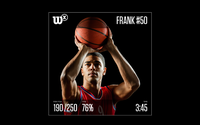Commentary
The Wilson X Connected Basketball: Managing the Net of Data
- by Chuck Martin , Staff Writer, October 20, 2015
 Much of the value of objects connected to the Internet is in the
information that can be gathered and then immediately used to enhance a consumer experience.
Much of the value of objects connected to the Internet is in the
information that can be gathered and then immediately used to enhance a consumer experience.
Generally, this happens through platforms behind the scenes.
And the Internet of Things is fueling the creating of more and more platforms to manage all sorts of things.
For example, in the world of beacons, Swirl has a platform to manage the flow of beacon-triggered in-store advertising and InMarket has a platform to manage and route consumers via various apps to specific products in a store, based on the location of both.
Boston-based Xively has a platform that allows the management of IoT devices, including automated tools that facilitate customer support via real-time contact information.
And now there’s a platform that quickly crunches and analyzes data from a basketball in real time and develops actionable insights from that data.
Sporting goods manufacturer Wilson Athletic recently introduced the Wilson X, a smart basketball, and needed a dashboard to view all the sensor data that would flood in.
Tracking in sports is nothing new, of course. The National Football League this year even started real-time tracking of the motions and on-field activities of players through sensors on the shoulder pads of all players.
But Wilson included the technology inside the ball so that no additional sensors had to be installed and the tracking information is provided to the consumer through Bluetooth and a mobile app.
A sensor inside the ball can track shots taken, baskets scored, three-pointers and the like.
The key is that for all that data to be useful in real time requires a platform where the analysis can occur and be translated for humans to understand.
The platform Wilson uses is from Chicago-based TempoIQ, which just introduced the latest iteration of its dashboard and technology that requires no coding on the part of the brand or marketer.
As more sensors become embedded in more things, the collective data from those things will start to provide high value.
“It’s becoming less about the Internet of Things and more about the insights of things,” TempoIQ CEO Steve Subar told me yesterday.
In addition to personal stats and information the consumer receives from various ball motions, Wilson also receives data insights.
“Wilson is getting insights they never had before,” said Subar.
Bouncing the ball activates the sensor, which allows Wilson to track same-day sales, since a ball typically is used a short time after being purchased.
Wilson could possibly aggregate information it never had, such as the scoring percentage of basketball players in Chicago compared to those in New York. All in real time.
The first phase of the Internet of Things starts with the connected objects.
Once the data from those objects starts to flow, robust platforms are needed to keep track and make sense of all that data.
In the Internet of Things, platforms rule.



